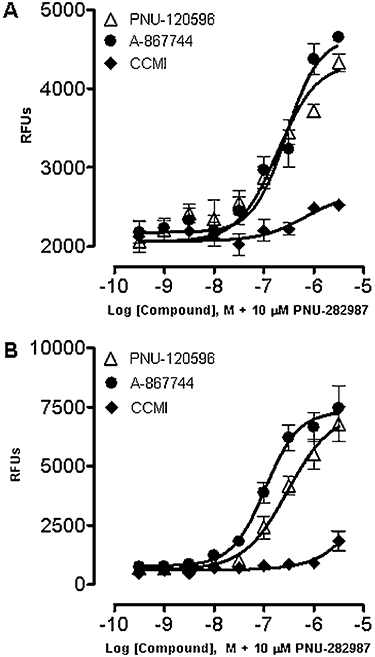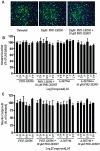Positive allosteric modulation of alpha7 neuronal nicotinic acetylcholine receptors: lack of cytotoxicity in PC12 cells and rat primary cortical neurons
- PMID: 20050184
- PMCID: PMC2807647
- DOI: 10.1111/j.1476-5381.2009.00474.x
Positive allosteric modulation of alpha7 neuronal nicotinic acetylcholine receptors: lack of cytotoxicity in PC12 cells and rat primary cortical neurons
Abstract
Background and purpose: alpha7-Nicotinic acetylcholine receptors (alpha7 nAChRs) play an important role in cognitive function. Positive allosteric modulators (PAMs) amplify effects of alpha7 nAChR agonist and could provide an approach for treatment of cognitive deficits in neuropsychiatric diseases. PAMs can either predominantly affect the apparent peak current response (type I) or increase both the apparent peak current response and duration of channel opening, due to prolonged desensitization (type II). The delay of receptor desensitization by type II PAMs raises the possibility of Ca2+-induced toxicity through prolonged activation of alpha7 nAChRs. The present study addresses whether type I and II PAMs exhibit different cytotoxicity profiles.
Experimental approach: The present studies evaluated cytotoxic effects of type I PAM [N-(4-chlorophenyl)]-alpha-[(4-chlorophenyl)-aminomethylene]-3-methyl-5-isoxazoleacet-amide (CCMI) and type II PAM 1-[5-chloro-2,4-dimethoxy-phenyl]-3-[5-methyl-isoxazol-3-yl]-urea (PNU-120596), or 4-[5-(4chloro-phenyl)-2-methyl-3-propionyl-pyrrol-1-yl]-benzenesulphonamide (A-867744). The studies used cultures of PC12 cells and primary cultures of rat cortical neuronal cells.
Key results: Our results showed that neither type I nor type II PAMs had any detrimental effect on cell integrity or cell viability. In particular, type II PAMs did not affect neuron number and neurite outgrowth under conditions when alpha7 nAChR activity was measured by Ca2+ influx and extracellular signal-regulated kinases 1 and 2 phosphorylation, following exposure to alpha7 nAChR agonists.
Conclusions and implications: This study demonstrated that both type I and type II alpha7 nAChR selective PAMs, although exhibiting differential electrophysiological profiles, did not exert cytotoxic effects in cells endogenously expressing alpha7 nAChRs.
Figures





Similar articles
-
In vitro pharmacological characterization of a novel selective alpha7 neuronal nicotinic acetylcholine receptor agonist ABT-107.J Pharmacol Exp Ther. 2010 Sep 1;334(3):863-74. doi: 10.1124/jpet.110.167072. Epub 2010 May 26. J Pharmacol Exp Ther. 2010. PMID: 20504915
-
In vitro pharmacological characterization of a novel allosteric modulator of alpha 7 neuronal acetylcholine receptor, 4-(5-(4-chlorophenyl)-2-methyl-3-propionyl-1H-pyrrol-1-yl)benzenesulfonamide (A-867744), exhibiting unique pharmacological profile.J Pharmacol Exp Ther. 2009 Jul;330(1):257-67. doi: 10.1124/jpet.109.151886. Epub 2009 Apr 23. J Pharmacol Exp Ther. 2009. PMID: 19389923
-
Distinct profiles of alpha7 nAChR positive allosteric modulation revealed by structurally diverse chemotypes.Mol Pharmacol. 2007 Sep;72(3):715-24. doi: 10.1124/mol.107.035410. Epub 2007 Jun 12. Mol Pharmacol. 2007. PMID: 17565004
-
Advances in the discovery of novel positive allosteric modulators of the alpha7 nicotinic acetylcholine receptor.Recent Pat CNS Drug Discov. 2007 Jun;2(2):99-106. doi: 10.2174/157488907780832751. Recent Pat CNS Drug Discov. 2007. PMID: 18221220 Review.
-
Silent agonists for α7 nicotinic acetylcholine receptors.Pharmacol Res. 2023 Apr;190:106736. doi: 10.1016/j.phrs.2023.106736. Epub 2023 Mar 20. Pharmacol Res. 2023. PMID: 36940890 Review.
Cited by
-
Nicotinic acetylcholine receptors at the single-channel level.Br J Pharmacol. 2018 Jun;175(11):1789-1804. doi: 10.1111/bph.13770. Epub 2017 Apr 8. Br J Pharmacol. 2018. PMID: 28261794 Free PMC article. Review.
-
The antinociceptive effects of nicotinic receptors α7-positive allosteric modulators in murine acute and tonic pain models.J Pharmacol Exp Ther. 2013 Jan;344(1):264-75. doi: 10.1124/jpet.112.197871. Epub 2012 Oct 31. J Pharmacol Exp Ther. 2013. PMID: 23115222 Free PMC article.
-
Cotinine: a potential new therapeutic agent against Alzheimer's disease.CNS Neurosci Ther. 2012 Jul;18(7):517-23. doi: 10.1111/j.1755-5949.2012.00317.x. Epub 2012 Apr 25. CNS Neurosci Ther. 2012. PMID: 22530628 Free PMC article. Review.
-
α7 nicotinic ACh receptors as a ligand-gated source of Ca(2+) ions: the search for a Ca(2+) optimum.Adv Exp Med Biol. 2012;740:603-38. doi: 10.1007/978-94-007-2888-2_27. Adv Exp Med Biol. 2012. PMID: 22453962 Free PMC article. Review.
-
Positive allosteric modulators as an approach to nicotinic acetylcholine receptor-targeted therapeutics: advantages and limitations.Biochem Pharmacol. 2011 Oct 15;82(8):915-30. doi: 10.1016/j.bcp.2011.05.001. Epub 2011 May 14. Biochem Pharmacol. 2011. PMID: 21575610 Free PMC article. Review.
References
-
- Anderson DJ, Bunnelle WH, Surber BW, Du J, Surowy CS, Tribollet E. 3H]A-585539[(1S,4S)-2,2-dimethyl-5-(6-phenylpyridazin-3-yl)-5-aza-2-azoniabicyclo [2.2.1]heptane], a novel high-affinity alpha7 neuronal nicotinic receptor agonist: radioligand binding characterization to rat and human brain. J Pharmacol Exp Ther. 2008;324:179–187. - PubMed
-
- Bertrand D, Gopalakrishnan M. Allosteric modulation of nicotinic acetylcholine receptors. Biochem Pharmacol. 2007;74:1155–1163. - PubMed
-
- Bettany JH, Levin ED. Ventral hippocampal alpha 7 nicotinic receptor blockade and chronic nicotine effects on memory performance in the radial-arm maze. Pharmacol Biochem Behav. 2001;70:467–474. - PubMed
Publication types
MeSH terms
Substances
LinkOut - more resources
Full Text Sources
Miscellaneous

